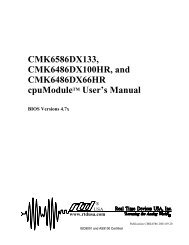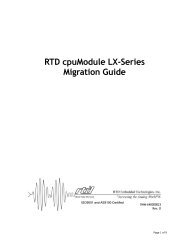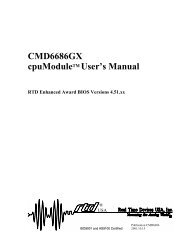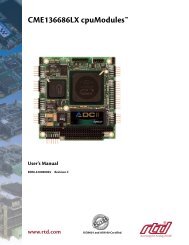CME34M Hardware Manual - RTD Embedded Technologies, Inc.
CME34M Hardware Manual - RTD Embedded Technologies, Inc.
CME34M Hardware Manual - RTD Embedded Technologies, Inc.
You also want an ePaper? Increase the reach of your titles
YUMPU automatically turns print PDFs into web optimized ePapers that Google loves.
Enhanced Intel SpeedStep (Core 2 Duo only)<br />
Enhanced Intel® SpeedStep® Technology has revolutionized thermal and power management by giving operating<br />
systems greater control over the processor’s operating frequency and input voltage. Systems can easily manage<br />
power consumption dynamically. Today’s embedded systems are demanding greater performance at equivalent<br />
levels of power consumption. Legacy hardware support for backplanes, board sizes and thermal solutions have<br />
forced design teams to place greater emphasis on power and thermal budgets. Intel has extended architectural<br />
innovation for saving power by implementing new features such as Enhanced Intel SpeedStep Technology.<br />
Enhanced Intel SpeedStep Technology allows the processor performance and power consumption levels to be<br />
modified while a system is functioning. This is accomplished via operating system or application software, which<br />
changes the processor speed and the processor core voltage while the system is operating. A variety of inputs<br />
such as system power source, processor thermal state, or operating system policy are used to determine the<br />
proper operating state.<br />
The software model behind Enhanced Intel SpeedStep Technology has ultimate control over the frequency and<br />
voltage transitions. This software model is a major step forward over previous implementations of Intel<br />
SpeedStep technology. Legacy versions of Intel SpeedStep technology required hardware support through the<br />
chipset. Enhanced Intel SpeedStep Technology has removed the chipset hardware requirement and only requires<br />
the support of the voltage regulator, processor and operating system. Centralization of the control mechanism<br />
and software interface to the processor, and reduced hardware overhead has reduced processor core<br />
unavailability time to 10 μs from the previous generation unavailability of 250 μs.<br />
Thermal Monitor<br />
The Intel ® Thermal Monitor is a feature on the <strong>CME34M</strong> that automatically throttles the CPU when the CPU<br />
exceeds its thermal limit. This allows the processor to operate for short durations at a higher frequency than the<br />
thermal solution or ambient temperature would otherwise allow. The thermal limit and duty cycle of the<br />
Thermal Monitor cannot be modified.<br />
A second thermal monitor is used to throttle the memory interface when the memory controller or the memory<br />
approaches it’s thermal limit. This ensures proper operation even under the harshest conditions. The thermal<br />
monitors operate independently of each other.<br />
aDIO with Wake-on-aDIO<br />
<strong>RTD</strong>’s exclusive aDIO is 12 digital bits configured as 8 bit-direction programmable and 4-bit port-direction<br />
programmable I/O, plus 2 strobe inputs giving you any combination of inputs and outputs. Match, event, and<br />
strobe interrupt modes mean no more wasting valuable processor time polling digital inputs. Interrupts are<br />
generated when the 8 bit-direction programmable digital inputs match a pattern or on any value change event.<br />
Bit masking allows selecting any subgroup of eight bits. The strobe input latches data into the bit-programmable<br />
port and generates an interrupt. Any of the interrupt modes can be used to generate a wake event from any<br />
standby/powerdown mode.<br />
BDM-610000076 Rev A Chapter 1: Introduction 3
















